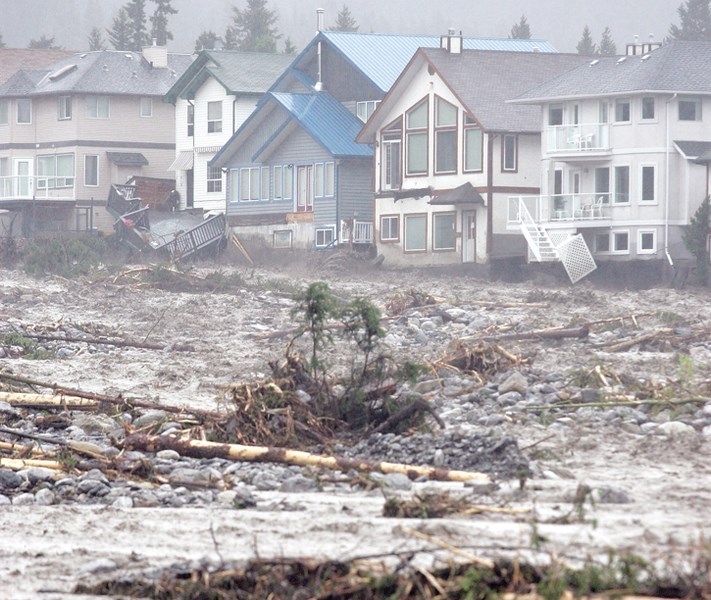The Town of Canmore is hoping to exchange land with Alberta Parks in the Cougar Creek watershed in order to build steep creek flood mitigation infrastructure.
The municipality has officially submitted its environmental impact assessment (EIA) and dam safety report to the provincial government for review and approval in order to construct a debris flood retention structure.
The structure is designed like a dam, but instead of holding back water, it is meant to hold back debris carried down the creek by stormwater and thus prevent boulders and trees from travelling downstream and eroding away the sides of the creek bank near homes that sit along it.
It is also designed to protect infrastructure downstream like the Elk Run Boulevard bridge and culverts, Trans-Canada Highway, Highway 1A and CP Rail tracks – all of which were heavy damaged in June 2013.
The proposed location of the debris dam is within Bow Valley Wildland Provincial Park, even though it sits within the municipal boundary, and is owned by the Government of Alberta.
General manager of municipal infrastructure Michael Fark said the proposal in front of Alberta Environment and Parks right now includes plans to sell or exchange the provincial parkland with the Town of Canmore.
“We have had substantial discussions with the province on that and ultimately what we decided is to go with a land transfer and a licence of occupation to access that land,” Fark said.
The alternative was an amendment to the provincial park act, or rezoning of the land.
Canmore Mayor John Borrowmn said the June 2013 storm that hit the community and dumped rainfall into the watersheds over several days, causing before unseen amounts of debris to come down those steep mountain creeks, resulted in tens of millions of dollars in damage to homes, business, municipal, provincial and federal infrastructure.
“We were very fortunate to not have lost any lives, but what we learned in the months afterwards is not only should we expect this kind of flooding to occur again, but it could be very much worse,” Borrowman said. “Shortly after the flood, residents began to question why it was that there had been development approved in Cougar Creek in the first place, an area that is now perhaps the most densely developed alluvial fan in Canada.
“The answer, in truth, is that development approvals given in the ’80s by provincial and municipal authorities were reasonable decisions based on the best understanding of the nature of steep creek flows at that time,” said Borrowman.
“However, immediately following the 2013 flood, council and administration agreed that we could not simply rebuild the neighbourhood while ignoring the serious hazard and risks we now know to be associated with our steep creeks.”
Beginning with Cougar Creek, the Town of Canmore began undertaking hazard and risk assessments of all steep creeks that experienced debris floods or debris flows.
Both are geotechnical terms used to describe when water mixed with rock, sediment and other materials comes down a steep watershed. Cougar Creek in particular was found to have a high risk for potential loss of human life, and 181 parcels of land have intolerable levels of individual safety risk.
Of all the possible mitigation strategies proposed, Borrowman said the debris retention structure costs the least, has the lowest environmental impact, and greatest risk reduction.
The estimated budget is $48 million – above a $39 million pricetag from the last time the debris dam was considered by council. All three levels of government have come to the table to fund the project, with Federal Minister of Infrastructure and Community Amarjeet Sohi in Canmore last Thursday (Oct. 13) to announce $14 million for the project.
The province has contributed $19 million from the Flood Recovery Erosion Control program, $2 million from the Disaster Recovery Program, $4 million from Alberta Transportation and the remainder is the Town of Canmore’s contribution to the overall project.
But Borrowman said the $48 million pricetag at this point represents contingencies while the design is finalized and before a tender process can begin.
“We are still internally budgeting or expecting a budget of approximately $40 million, so this announcement of just over $14 million from the federal government is so welcome and really critical to the success of the project,” said the mayor.
Of course, Fark said, a major project like the debris flood retention structure should include funds for contingency, and a 10 per cent contingency would be $4 million.
“We have to include some contingency because the time between when the design is complete and when the project will actually be implemented could be a number of years and there are cost escalations or differences we have to factor into that,” he said.
As for timelines, with the EIA and dam safety report submitted, Fark said the timeline for Alberta Environment’s review – which will involve 15 different provincial government departments – is 12 to 18 months.
“We are optimistic and the best case scenario is we will be in the ground in late 2017,” he said. “There is a possibility it could be as late as early in 2018 until we are in the ground, and we still anticipate a two- to three-year timeline for construction.”




